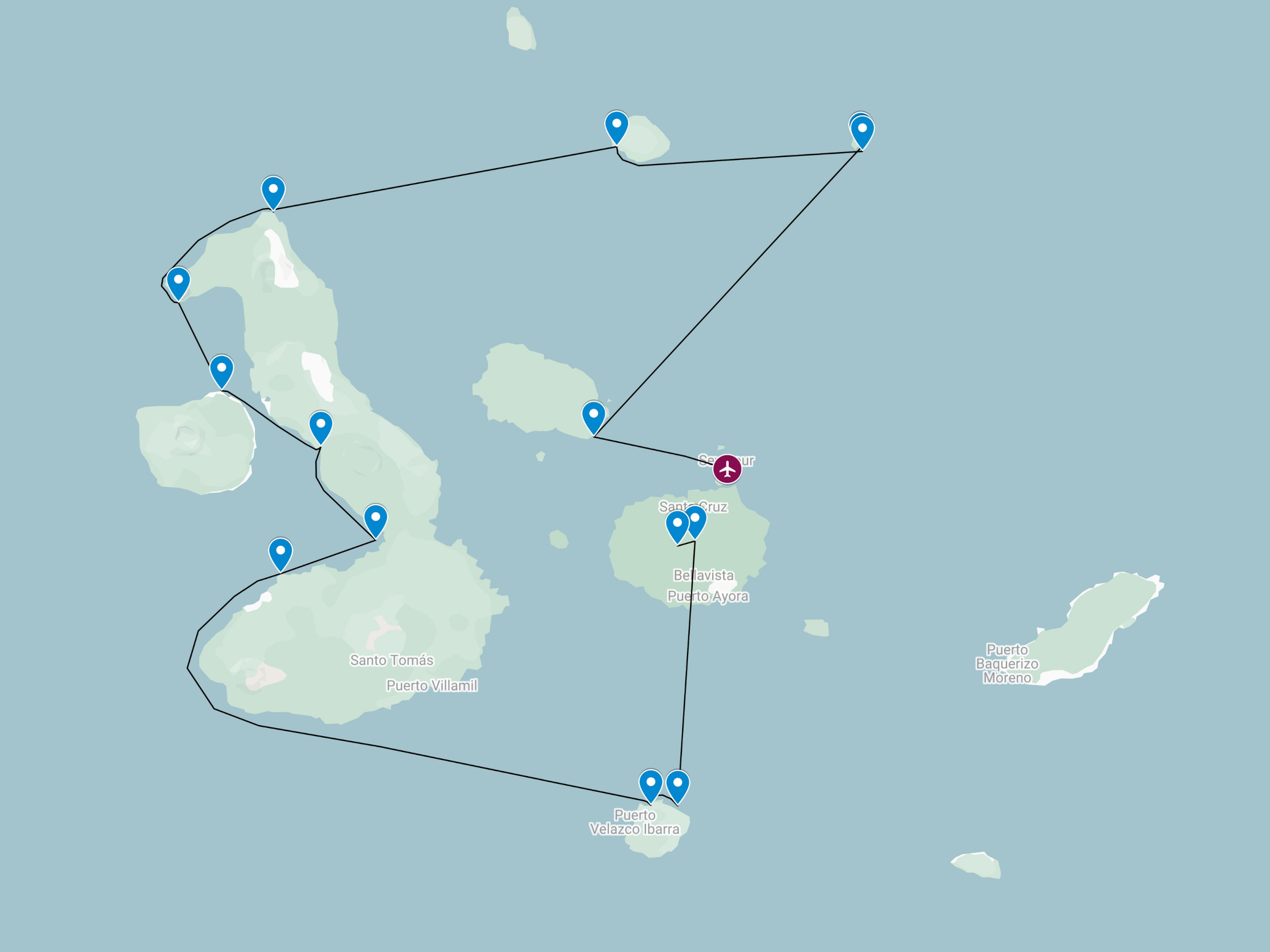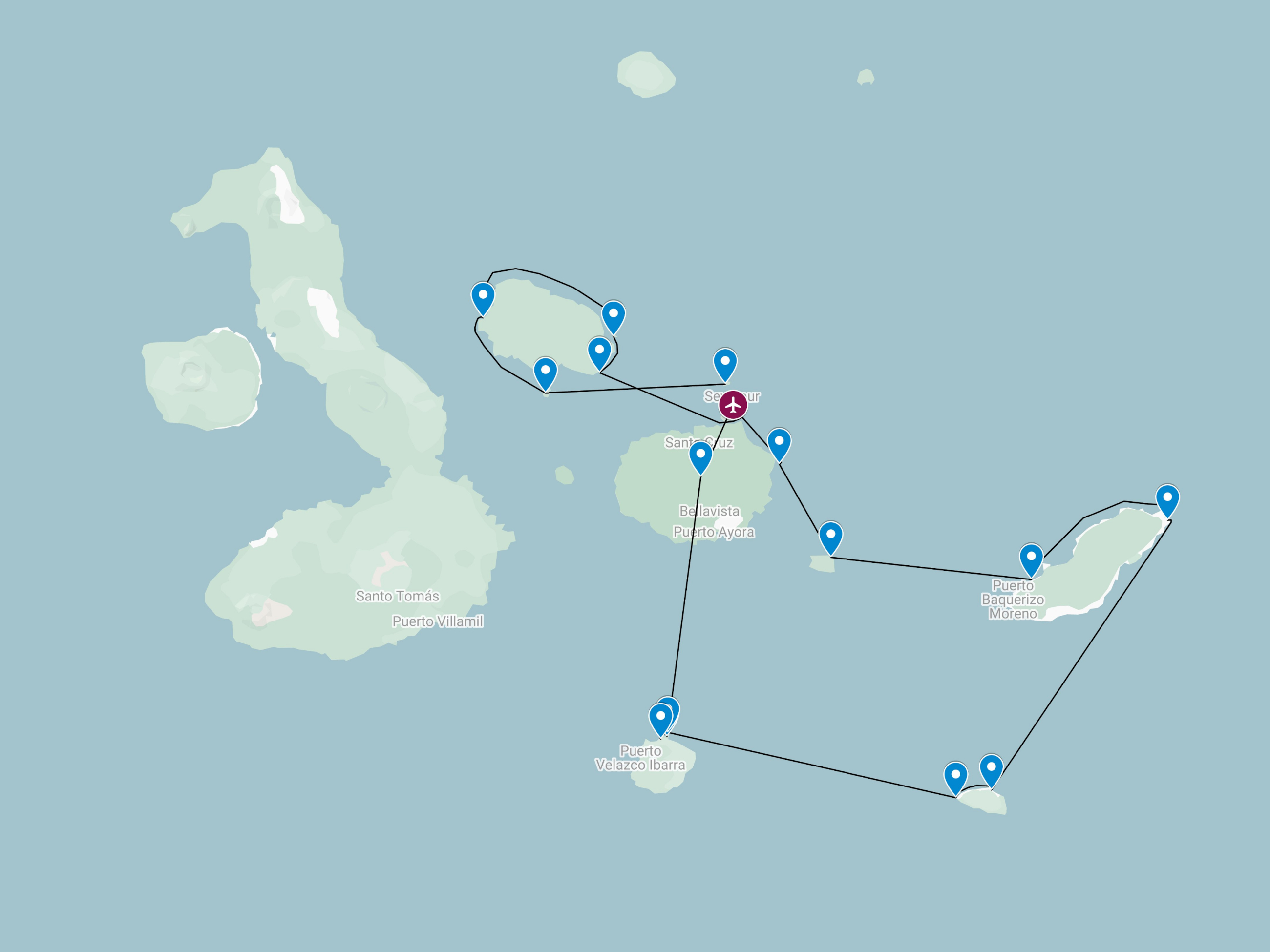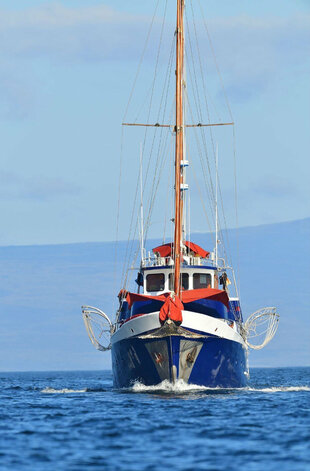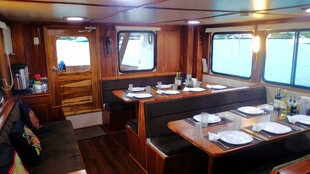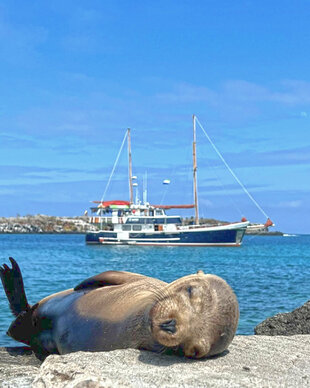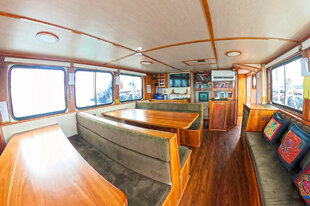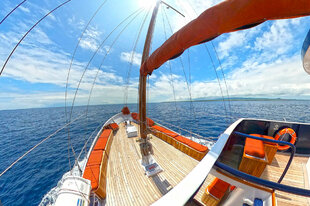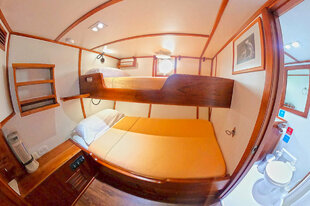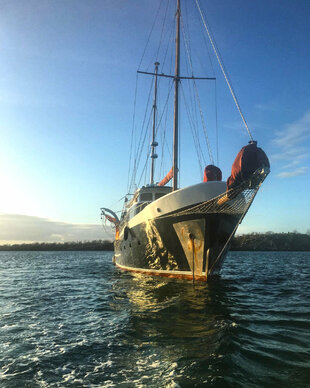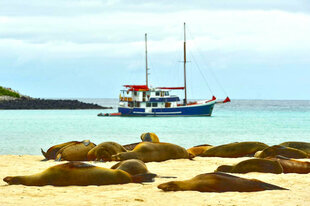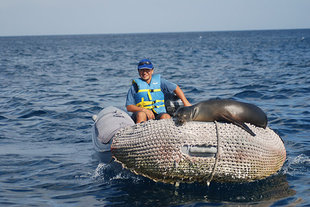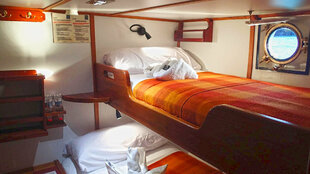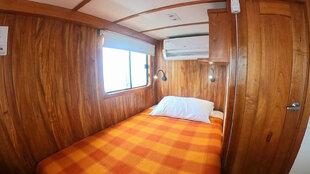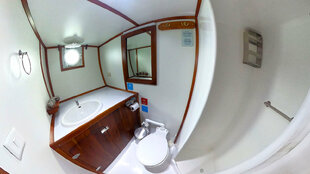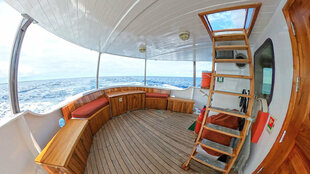Samba was built in Holland and is an impressive 78-foot steel-hulled motor yacht with stabilising sail. Her style is both classically nautical and reassuringly solid & safe.
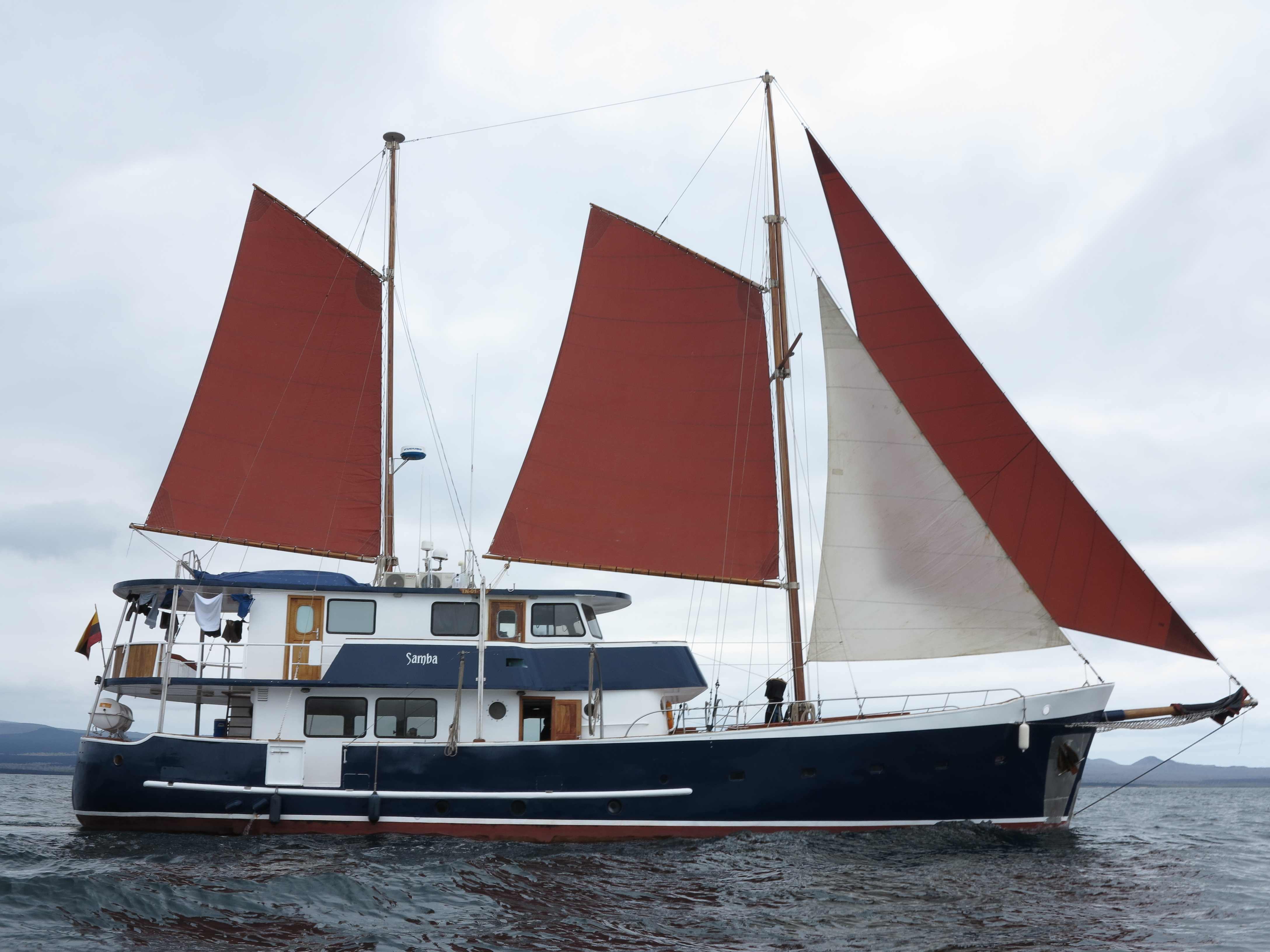
Samba is ideal for anyone seeking a small group size, accommodating a maximum of just 14 passengers in her six air-conditioned ensuite twin cabins and one double cabin. Samba's friendly and attentive crew achieve an intimate and friendly atmosphere, delivering passengers a journey of a lifetime.
Guests can relax on her spacious decks, which are ideal areas for dolphin and whale watching or simply soaking up the sun. With a choice of both inside and outside dining areas, guests can choose to eat in the cosy salon or opt for an al fresco supper under the stars.
With her carefully considered design and elegant interior, Samba offers a comfortable and authentic sailing experience. A key feature on this vessel is the number of public areas she boasts, including comfortable settees and sun loungers and aft dining facilities. The plentiful deck space provides great opportunities for group activities, but also allows guests to escape and have some alone time if needed.
Wildlife & Photography
The main focus of this trip is to experience the Galapagos’ unique wildlife and landscapes above, on and below the water. All itineraries include activities like hiking, kayaking, snorkelling, panga rides and swimming on excursions which take place twice daily, helping to give you the opportunity to explore the archipelago from different perspectives.
Each of the islands provides its own individual environment due to their age differences and stages of colonisation, which can differ by millions of years. As you make your way through any of the itineraries here, you will notice gradual changes in the landscapes and wildlife which you are surrounded by. Some of the wildlife which you can hope to see here includes Galapagos Sea Lions, Marine and Land Iguanas, Nazca and Blue-Footed Boobies, Galapagos Tortoises, Galapagos Penguins and Flightless Cormorants, among many others.
The great abundance and variety of life here makes this trip ideal for photographers. There are plenty of opportunities for every photographer to get their shots – macros of sunbathing Marine Iguanas, wide-angles of Sea Lion colonies and the islands and underwater captures of Sharks and Rays are just some of the possibilities here.
Even though the trips offered here explore a lot of the archipelago’s wonders, there are many other ways which you can explore the Galapagos Islands. If you wanted to extend your stay here to experience more of this location, you could book an add-on experience, such as a dive liveaboard from our Galapagos Dive Liveaboards page or one from our Galapagos page. We also offer trips in mainland Ecuador which you could choose to experience too.
Technical Specifications
| Category: | Tourist Superior Class |
| Departures: | Thursday – Sunday |
| Capacity: | 14 Passengers |
| Type: | Steel-hulled motor yacht with stabilizing sail |
| LOA: | 78 feet / 23.77 metres |
| Beam: | 18 feet / 5.48 metres |
| Displacement: | 134 tons |
| Engines: | Very efficient Twin DAV diesel engines 280 HP-CUMMINS that only use a remarkable 6 gallons of diesel every hour! |
| Range: | 2.500 miles |
| Speed: | 8.5 knots cruising |
| Sail: | Steadying sails |
| Water capacity: | 1,500 gallons and water maker |
| Accommodations: | 6 air-conditioned double cabins and 1 exterior double bed cabin, all with private bathrooms and hot water. An ample dining-room/salon connects to an outdoor dining facility with large tables, 32″ High Definition LCD TV, DVD video equipment, sound-system, mini-library with books and videos and a small bar. |
| Crew: | 6 + licensed Naturalist Guide |
| Navigation: | Furuno Navnet Radar, Plotter and Sonar, GPS, VHF & SSB radios, two tenders with outboard motor |
| Safety: | One self-contained 20-passenger life raft, EPIRB, two bi-directional VHF emergency-radios, one VHF (Motorola) wide-range radio, VHF and HF radios and one cell-phone communication system, life jackets, fire extinguishers, safety smoke and fire detectors and overhead sprinkler systems, A.B.C fire-control system and CO2 bank for the engine room. |
Itinerary
Each itinerary is designed as just a single part of your Galapagos experience and are combinable. We recommend combining itineraries for a more comprehensive visit to the Galapagos Islands.
Please note that these itineraries are subject to change without notice due to seasonal changes, last minute weather conditions and the decision of the Galapagos National Park authority.
Day 1 (Tuesday) – Arrival & Mosquera
AM: Arrival, Baltra Island
Upon arrival Baltra, travellers pass through an airport inspection point to make sure that no foreign plants or animals are introduced to the islands, and to pay the park entrance fee of $200 (unless it has been prepaid). A guide will meet you, help you collect your luggage and escort you on a short bus ride to the harbour.
PM: Islote Mosquera
Mosquera is a low white sand island which lies in the Itabaca Channel between Baltra Island (South Seymour) and North Seymour. It is surrounded by coral reefs, providing protected conditions for snorkelling and scuba diving. Above water, it has a large sealion colony and is good for spotting birds like America oyster catchers, blue-footed boobies and lava gulls.
Day 2 (Wednesday) – Darwin Bay & Prince Philip’s Steps
AM: Darwin Bay, Genovesa Island
Inside the submerged caldera of Genovesa lies Darwin Bay, whose diameter is more than 1.5km (1 mile) and it is almost 200 m (650 ft) deep. The small area will surprise you repeatedly, walking along a coral sand beach, crossing barren lava formations and creeks, passing tidal pools, shrubs and further ahead following the top of some cliffs. With this peaceful surrounding, every species has occupied its own ecological niche (or habitat) without disturbing others. There is great birdlife here with starring species including Red-Footed Boobies, Great Frigatebirds & Laval Gulls. These often share the beach with Galapagos Sea Lions.
PM: El Barranco, Genovesa Island
Before landing, you will take an inflatable dinghy-ride along the eastern arm of the caldera. As we approach, the soaring 25m / 80ft high walls become overwhelming. Sometimes, a Galapagos fur seal is resting or a seabird is nesting on one of the ledges at the base. You will then have to hike and overcome the steep stairs from the landing dock to a bush of palo santo shrubs on top. Red-footed boobies gratefully use these scarce nesting places so that they don’t have to nest on the rocky ground. Upon arriving at the edge of the rim, the bushes open up and you can enjoy panoramic views, a sea breeze and the amazing flying skills of countless seabirds. Following the exposed rim, you will first pass a place where we usually encounter a colony of Nazca boobies; and finally reach the extensive storm petrel nesting places. If you are lucky, you can spot the well camouflaged short-eared owl hunting for them on foot!
Day 3 (Thursday) – Meija Point & Black Beach
AM: Punta Mejia, Marchena Island
Punta Meija is a snorkelling location just off Marchena Island, one of the largest islands in the north of the Galapagos Archipelago. Snorkelling here, you can expect to see a range of tropical fish, rays and sharks.
PM: Playa Negra, Marchena Island
Sailing to Playa Negra from Punta Mejia takes around 45 minutes and sometimes offers sightings of cetaceans such as Bottlenose Dolphins. At Playa Negra, you can go snorkelling around the recently-formed lava grotto where marine iguanas feed.
Day 4 (Friday) – Albemarle Point & Vicente Roca Point
AM: Punta Albemarle, Isabela Island
Punta Albemarle was an American radar station used to help prevent Japan destroying the Panama channel. Now a small and derelict building, this location is home to some great wildlife. Recent lava flows provide nesting sites for flightless cormorants and basking sites for marine iguanas.
PM: Punta Vicente Roca, Isabela Island
There are great snorkelling opportunities at Vicente Roca Point thanks to upwelling cold-water currents here. Marine life in the area includes Galapagos Penguins. Other animals which you can hope to see here are Nazca & Blue-Footed Boobies, Brown Pelicans & Flightless Cormorants.
Day 5 (Saturday) – Espinosa Point & Urbina Bay
AM: Punta Espinoza, Fernandina Island
Fernandina is the third largest island in the archipelago and has a single visitor site: Punta Espinoza, located at the northeastern tip of the island. Here, marine iguanas conglomerate in larger groups than on any other island. They bask around in the sand, swim near the shore and sometimes block the way at the landing dock. Among the unique species found here, we can find the flightless cormorant.
PM: Urbina Bay, Isabela Island
Urbina Bay is on the west coast of Isabela and has a recently uplifted seabed which has forced corals up above the water’s surface, providing a unique snorkelling experience. There are 2 treks at this bay which offer chances of seeing Galapagos Tortoises & large Land Iguanas amongst other wildlife including Flycatchers, Finches & Mockingbirds.
Day 6 (Sunday) – Elizabeth Bay & Moreno Point
AM: Bahía Elizabeth, Isabela Island
This is a marine visitor site, so the excursion has no landing point. Your panga ride starts with a visit to the Marielas islets: home to the largest and most important penguin colony in the Galapagos Islands. The excursion continues into a cove, surrounded by red mangroves, where you can admire their red roots and green leaves. Here, you might be able to observe sea turtles, flightless cormorants, spotted eagle rays, golden cownose rays, brown pelicans and sealions. You might also see Galapagos hawks soaring overhead with schools of pompano and dorado fish swimming down below.
PM: Punta Moreno, Isabela Island
Punta Moreno is the site of a large dry lava field created by Cero Azul Volcano. This is a strange landscape, with vegetation-less lava, tidal lagoons and mangroves all in the same space. In some of the large tidal lagoons and pools, you may be able to see Green Turtles and Sharks. The mangrove forests provide habitat for other animals like Galapagos Flamingos, Brown Pelicans and some Galapagos Penguins.
Day 7 (Monday) – Post Office Bay & Champion
AM: Post Office Bay, Floreana Island
Post Office Bay is primarily of cultural significance. In times before there was a reliable postal service, a barrel onshore was a point where British 16th century whalers and poachers could post a letter. You are encouraged to write and address one or two post cards; whilst at the same time picking out any which are addressed close to your home, which you are happy to hand deliver when you return.
Shallow waters offshore are lovely to swim in. If you doon a mask and snorkel, you might see Pacific green turtles which often graze here.
PM: Isla Champion, Floreana Island
Bottlenose dolphins frequently escort our passage to Champion Islet and you can see them from nearby jumping the bow wave. Underwater, Galapagos sea lions are playful acrobats that become the number one attraction. There are also lots of reef fish, and perhaps a green Pacific turtle. An inflatable dinghy ride along the shoreline of this islet offers sightings of lots of seabirds that are endemic to the archipelago, including Galapagos penguins, blue-footed boobies, magnificent frigate birds and red-billed tropicbirds, swallow-tailed gulls and lava herons. A birdwatcher’s dream is to get a glimpse of the Charles mockingbird on top of Opuntia cacti. This mockingbird is a scientific and historic key species, because it put Darwin on track of his theory of 'adaptive radiation'.
Day 8 (Tuesday) – Highlands / Twin Craters & Departure
AM: Highlands & Los Gemelos, Santa Cruz Island
You will have breakfast at 6:00 for a checkout at 7:00 before going on a trip to the Highlands of Santa Cruz Island.
The road to the highlands leaves from Bellavista, a small village located a 15-minute drive from Santa Cruz’ main town of Puerto Ayora. The road passes through the Galapagos’ most productive agricultural zone, up to the National Park boundary. We find Miconia vegetation at this altitude, changing to the Fern and Sedge zone as we ascend further. With clear weather, we can enjoy beautiful scenes of rolling hills and extinct volcanic cones covered with grass and lush greenery all year round. In the Highlands is El Chato Reserve, where Giant Galapagos Tortoises can be observed in the wild – the iconic species which gave the Galapagos Islands their name. Other species to see at this reserve include Short-Eared Owls, Yellow Warblers & Finches. More elusive species which can be difficult to spot here are Galapagos Rails & Paint-Billed Crakes.
Day 1 (Tuesday) – Arrival & Santa Cruz Highlands
AM: Arrival, Baltra Island
Upon arrival Baltra, travellers pass through an airport inspection point to make sure that no foreign plants or animals are introduced to the islands, and to pay the park entrance fee of $200 (unless it has been prepaid). A guide will meet you, help you collect your luggage and escort you on a short bus ride to the harbour.
PM: Highlands, Santa Cruz Island
The road to the highlands leaves from Bellavista, a small village located a 15-minute drive from Santa Cruz’ main town of Puerto Ayora. The road passes through the Galapagos’ most productive agricultural zone, up to the National Park boundary. We find Miconia vegetation at this altitude, changing to the Fern and Sedge zone as we ascend further. With clear weather, we can enjoy beautiful scenes of rolling hills and extinct volcanic cones covered with grass and lush greenery all year round. In the Highlands is El Chato Reserve, where Giant Galapagos Tortoises can be observed in the wild – the iconic species which gave the Galapagos Islands their name. Other species to see at this reserve include Short-Eared Owls, Yellow Warblers & Finches. More elusive species which can be difficult to spot here are Galapagos Rails & Paint-Billed Crakes.
Overnight navigation south to Floreana Island.
Day 2 (Wednesday) – Cormorant Point / Devil’s Crown & Baroness Lookout
AM: Punta Cormorant & Devil’s Crown, Floreana Island
The peninsula of Punta Cormorant (Cormorant Point) marks the extreme northern cape of Floreana – an island formed from smaller volcanic cones, covered now by tropical dry forest (palo santo). At the landing beach, you are likely to be welcomed by a small colony of Galapagos sealions. The green sand on this beach contains a high percentage of glassy olivine crystals which have been blown out by the surrounding tuff cones.
The ‘flour sand’ beach on the southern side of the peninsula is made up of white coral ground into sand by Parrotfish. It feels very smooth on the feet. You may be able to spot stingrays who use the sandy bottom to bury themselves. During the first months of the year, Pacific green turtles come ashore to dig a nest in which to bury their eggs.
Devil’s Crown is a small outcrop of rocks off the coast of Floreana near Cormorant Point with a circular arrangement which gives them their name. Here, there is spectacular snorkelling with an abundance of reef fish such as Parrotfish, Surgeonfish & King Angelfish as well as Sharks, Manta Rays & Hammerhead Sharks.
PM: Baroness Lookout, Floreana Island
Baroness Lookout is a tuff in Floreana close to Post Office Bay. There are great Mangrove Forests here and a beautiful coastline where you can hope to have great marine life encounters with Sea Lions, Turtles & possibly Galapagos Penguins. You will have a chance to navigate through a small set of islets here by kayak or panga to see a sealion colony and mangrove forest.
Day 3 (Thursday) – Suarez Point & Gardner Islet / Gardner Bay
AM: Punta Suarez, Española Island
Huge ocean waves crash onto the southern basaltic cliffs of Suarez Point, forming a spectacular blowhole. where the water sprays metres high into the air (depending on the season, the tide and how strongly the sea breeze pushes the waves). This location is home to the only breeding colony of Waved Albatross in the Galapagos. You can also see wildlife such as marine iguanas, Nazca and Blue-Footed Boobies. Take your time for a meditative break in silence at this emblematic viewpoint and convert this unforgettable moment in a lifetime experience.
PM: Isla Gardner & Bahía Gardner, Española Island
Gardner Islet is just off the coast of Española and is a great snorkelling site for a wide range of marine life. Some of the main creatures you can hope to see as you snorkel or kayak here (condition dependant) include Galapagos Sea Lions, Eels, Pufferfish and Starfish.
The striking white beach at Gardner Bay is an important breeding site for Pacific green turtles. However, without doubt its main attraction is the Galapagos sea lion colony. Females stay year-round in this nursery, suckling their pups up to an age of 3 years, although they start to fish after 5 months of their birth. During the breeding and mating season, the colony becomes even bigger.
Day 4 (Friday) – Pitt Point & Lobos Island
AM: Punta Pitt, San Cristobal Island
Pitt Point is a stunning area with olivine beach contrasted against volcanic tuff making it great as a location for experiencing from both land and water. It is a haven for many sea birds which nest along its coastline. It is one of the few places in the Galapagos where you can see all 3 types of Boobies. Even more unique, it is also home to Frigatebirds & a Sea Lion colony.
PM: Isla Lobos, San Cristobal Island
The Lobos Islet’s beach harbours a colony of Galapagos sea lions. As in other colonies in the archipelago, you can approach nurturing females within a few metres. In the breeding season this colony is also visited by territorial males, defending and mating the harem on their section of beach. This low islet is home to more than just Galapagos sea lions. Two other emblematic species breed here: male blue-footed boobies and great frigate birds. In season, booby males try to impress females with clumsy dances, showing off how blue (and healthy) their feet are. Male frigatebirds inflate and wobble huge red throat poaches called gulas. Young fluffy offspring cry for food, whilst juveniles try out their wings ready to fly.
Day 5 (Saturday) – Barrington Bay & South Plaza
AM: Bahía Barrington, Santa Fé Island
Barrington Bay is one of the most picturesque inlets in the Galapagos. The white sand on the seabed reflects the light to turn the calm waters turquoise. A small forest of gigantic prickly pear cactus grows on a peninsula that keeps the bay sheltered. All the aforementioned provide an ideal environment for a large sea lion colony. Santa Fe is an extinct volcano and it has been isolated from other islands long enough to have an endemic land iguana. Paler yellow than its relatives, the Barrington terrestrial iguana has a primitive morphology. Galapagos Hawks, mockingbirds, lava lizards, finches and endemic rice rats keep it company. The snorkelling won't disappoint you.
PM: Isla Plaza Sur
South Plaza is a beautiful island formed out of lava which bubbled up to the sea surface. It is relatively small but very diverse in its botany and very good for spotting Land Iguanas. hybrid Iguanas exist here, created through the mating of male marine iguanas and female land iguanas.
There are approximately 1,000 Galapagos Sealions on the island and birdlife is plentiful. Cliffs on the western side are nesting sites for Blue-footed and Nazca Boobies, whilst we can find Darwin's Finches amongst the rocks of the eastern side, Lava Gulls and lovely Swallow-tail Gulls. Red-billed Tropicbirds often swoop low overhead, whilst in the sea beneath the western cliffs we can often see schools of fish close to the surface.
This island can be one of the best for photography.
Day 6 (Sunday) – Chinese Hat & Bartolomé
AM: Sombrero Chino
Sombrero Chino, or Chinese Hat, aptly named due to its slowly sloping sides giving the island an appearance resembling that of a Chinese hat, is one of the smallest in the peninsula. The recent formation of the island gives it a unique environment where there are different stages of colonisation by pioneer species at this location compared to others you will have visited. Walking on the island is a great way to experience the island’s wildlife, including Sally Lightfoot Crabs, Marine Iguanas, Galapagos Sea Lions & Lava Lizards. Out of the cracks in dried-up lava, lava cacti are a common sight. The waters of the island are calm & home to White-Tip Reef Sharks, so there is ample opportunity for snorkelling & kayaking here too.
PM: Isla Bartolomé
One of the Galapagos’ most iconic locations, the beautiful volcanic islet of Bartolomé is among the youngest islands in the archipelago. On a geological scale Bartolomé was only recently born out of volcanic activity. Although at first sight lifeless, Bartolomé offers some of the wildest landscapes and best panoramas of the entire archipelago. To enjoy the postcard view of the idyllic Pinnacle Bay, you have to climb steps to a viewpoint on top of the island (114m / 375ft). Enter a dramatic world of threatening (though extinguished) nearby spatter cones, craters, and lightweight lava droplets that have been spewed out by fiery fountains. The Summit Trail is also ideal for witnessing how scanty pioneer vegetation such as lava cacti manage to take root on the bare virgin lava fields.
Day 7 (Monday) – Egas Port & Rábida
AM: Puerto Egas, Santiago Island
Puerto Egas is a black beach located at the west side of Santiago Island. Volcanic tuff deposits formed this special black sand beach and made it the main attraction of the Island. This site is called Puerto Egas because Hector Egas attempted to exploit the salt, which failed because the price of salt on mainland South America was too low to make it a viable export. There is a trail which follows the coastline here for sightings of Marine Iguanas, Galapagos Sea Lions and many sea birds. Land Iguanas were reintroduced to the island as recently as 2019, so look out for these as you walk. At the end of the trail is a small Galapagos Fur Seal colony. If you snorkel from the beach here, you may be able to see Turtles, a range of Fish and Reef Sharks.
PM: Rábida Island
Rábida Island is unique because of the red colour of the rocks and sand. The volcanic material on this island is very porous and external factors such as rain, saltwater and sea breeze have acted as an oxidising agent. A short walk along a trail leads us to a coastal lagoon behind the beach where we can see land birds including finches, doves, yellow warblers and mockingbirds; seabirds such as pelicans, masked and blue-footed boobies; and of non-feathered species you can hope to see marine iguanas and sealions. Our team will take you to a small brackish lagoon where you can anticipate a colony of flamingos.
Day 8 (Tuesday) – North Seymour & Departure
AM: Isla Seymour Norté
This islet is one of most visited sites in the Galapagos and it is teeming with birdlife. An easy circular path takes you through the archipelago’s most extensive colonies of blue-footed boobies and frigate birds. At the beginning of the breeding season, adult frigatebird-males blow up their vivid red pouches (gulas) to impressive football-sized balloons. This is one of the few spots where you can compare the magnificent and the great frigatebird breeding next to each other.
You are likely to come across several land iguanas on North Seymour and the coast can be a good place to spot Galapagos sealions.
After North Seymour, you will board the boat again at 8:00 for breakfast and should be ready to check out by 9:00.
Dates
10% surcharge for Christmas & New Year's Eve departures.
23% Child Discount applies for children age less than 14 years by the time they board this ship.
Our prices include
Accommodation in double cabin
Meals onboard
Naturalist guide
Excursions outlined in the itinerary
Snorkelling equipment & wetsuits
Kayaks & paddleboards
Not included
Flights to/from the Galapagos
Bus transport to/from airport
Galapagos National Park entrance fee ($200)
Migration Card ($20)
Drinks, tips & personal expenses
Single Supplements
If you are willing to share your cabin with another person of the same gender then there is no single supplement. For single cabin occupancy add 45% to the per person cabin price.

